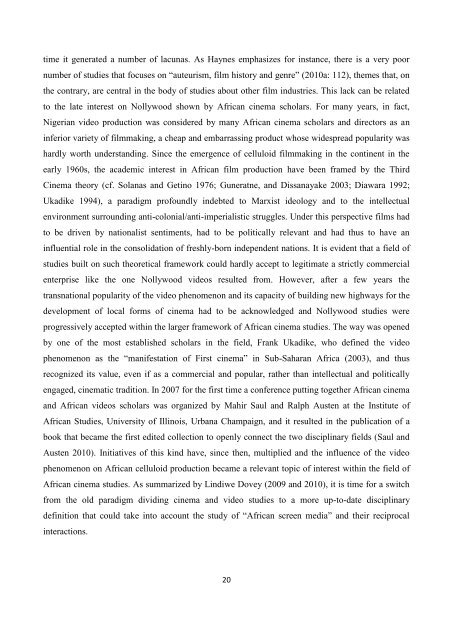Create successful ePaper yourself
Turn your PDF publications into a flip-book with our unique Google optimized e-Paper software.
time it generated a number of lacunas. As Haynes emphasizes for instance, there is a very poornumber of studies that focuses on “auteurism, film history and genre” (2010a: 112), themes that, onthe contrary, are central in the body of studies about other film industries. This lack can be relatedto the late interest on Nollywood shown by African cinema scholars. For many years, in fact,Nigerian video production was considered by many African cinema scholars and directors as aninferior variety of filmmaking, a cheap and embarrassing product whose widespread popularity washardly worth understanding. Since the emergence of celluloid filmmaking in the continent in theearly 1960s, the academic interest in African film production have been framed by the ThirdCinema theory (cf. Solanas and Getino 1976; Guneratne, and Dissanayake 2003; Diawara 1992;Ukadike 1994), a paradigm profoundly indebted to Marxist ideology and to the intellectualenvironment surrounding anti-colonial/anti-imperialistic struggles. Under this perspective films hadto be driven by nationalist sentiments, had to be politically relevant and had thus to have aninfluential role in the consolidation of freshly-born independent nations. It is evident that a field ofstudies built on such theoretical framework could hardly accept to legitimate a strictly commercialenterprise like the one Nollywood videos resulted from. However, after a few years thetransnational popularity of the video phenomenon and its capacity of building new highways for thedevelopment of local forms of cinema had to be acknowledged and Nollywood studies wereprogressively accepted within the larger framework of African cinema studies. The way was openedby one of the most established scholars in the field, Frank Ukadike, who defined the videophenomenon as the “manifestation of First cinema” in Sub-Saharan Africa (2003), and thusrecognized its value, even if as a commercial and popular, rather than intellectual and politicallyengaged, cinematic tradition. In 2007 for the first time a conference putting together African cinemaand African videos scholars was organized by Mahir Saul and Ralph Austen at the Institute ofAfrican Studies, University of Illinois, Urbana Champaign, and it resulted in the publication of abook that became the first edited collection to openly connect the two disciplinary fields (Saul andAusten 2010). Initiatives of this kind have, since then, multiplied and the influence of the videophenomenon on African celluloid production became a relevant topic of interest within the field ofAfrican cinema studies. As summarized by Lindiwe Dovey (2009 and 2010), it is time for a switchfrom the old paradigm dividing cinema and video studies to a more up-to-date disciplinarydefinition that could take into account the study of “African screen media” and their reciprocalinteractions.20
















